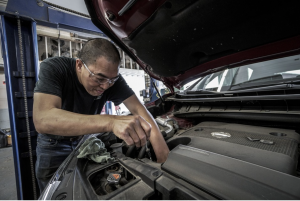When a truck tire breaks apart, tire debris can become a deadly projectile thrown through the air landing on vehicles.
Road debris was cited as a factor in a total of more than 200,000 police-reported crashes causing 500 fatal injuries in study data collected by AAA from 2011-2014. Debris can cause flat tires, broken windshields, damage to undercarriages, and motor vehicles leading to overreaction by passenger vehicle drivers and big rigs alike. Because controlling a big rig is more difficult, a truck driver must be acutely aware of their surroundings and keep a lookout for situations involving debris falling off large cargo loads, or branches falling during storms that may lead to skidding and sliding out of control as the braking distance of a big rig is much longer than that of a passenger vehicle. An accident attorney can help with insurance claims, or legal action after an accident causes harm and injury.
Commercial vehicle maintenance
Deviations in mechanical inspections and safety measures by truck drivers can cause catastrophic injury and death, increases in insurance premiums, and loss of expensive property and cargo. One effort to keep trucks safe and reduce roadway incidents is required spot checking of equipment before each trip by drivers. The AAA Study revealed that about two-thirds of debris-related crashes are the result of items falling from a vehicle due to improper maintenance and unsecured loads. The most common types of vehicle debris are:
- Parts becoming detached from a vehicle (tires, wheels, etc.) and falling onto the roadway
- Trailers becoming separated and hitting another vehicle or landing on the roadway
- Unsecured cargo like furniture, appliances, or overweight cargo loads resulting in items falling onto the roadway.
Truck regulations and maintenance
The equipment that must be checked before trips includes:
- service brakes, including trailer-brake connections.
- Parking brakes.
- Lighting devices and reflectors.
- Steering mechanisms.
- Horn.
- Tires – it is common for a truck to lose a tire, or for tread to break apart.
- Windshield wipers.
- Coupling devices.
- Wheels and rims.
- Rear mirror.
- Emergency notification markers and equipment.
Loose tire injuries

When a truck tire breaks apart, tire debris can become a deadly projectile thrown through the air landing on vehicles, or causing dangerous conditions on the highway itself, leading drivers to swerve and lose control of their vehicles.
Conditions that may cause a truck tire to break or come loose include:
- Under-inflation,
- Tread burn,
- Tread separation,
- Spare tire use,
- Problems with the wheel, or rim.
Liability for wheel separation accidents
A truck accident lawyer in California can help identify possible defendants when a truck wheel, or truck tire causes an injury on California roadways and those parties include a truck driver who failed to inspect tires, a truck owner who did not provide wheel and tire maintenance and a tire manufacturer in cases of tire defects. California is a “fault state” which means that the party found to be responsible for the accident will have to compensate the other party involved in the accident.
Damages
Damages covered include medical bills up to the time of death, lost wages (current and future), property damages and wrongful death claims to secure survivors financial stability of the deceased was an important part of the family income.
Seek legal counsel
When accidental injury, property damage and/or loss of life occurs because of a flying tire, an accident victim will need to hire an experienced Chula Vista truck accident lawyer, who is familiar with industry standards and laws, to investigate and prove liability for the accident.
Sources:
- https://www.nhtsa.gov/research-data/fatality-analysis-reporting-system-fars
- https://leginfo.legislature.ca.gov/faces/codes_displaySection.xhtml?lawCode=VEH§ionNum=20001


Join the conversation!